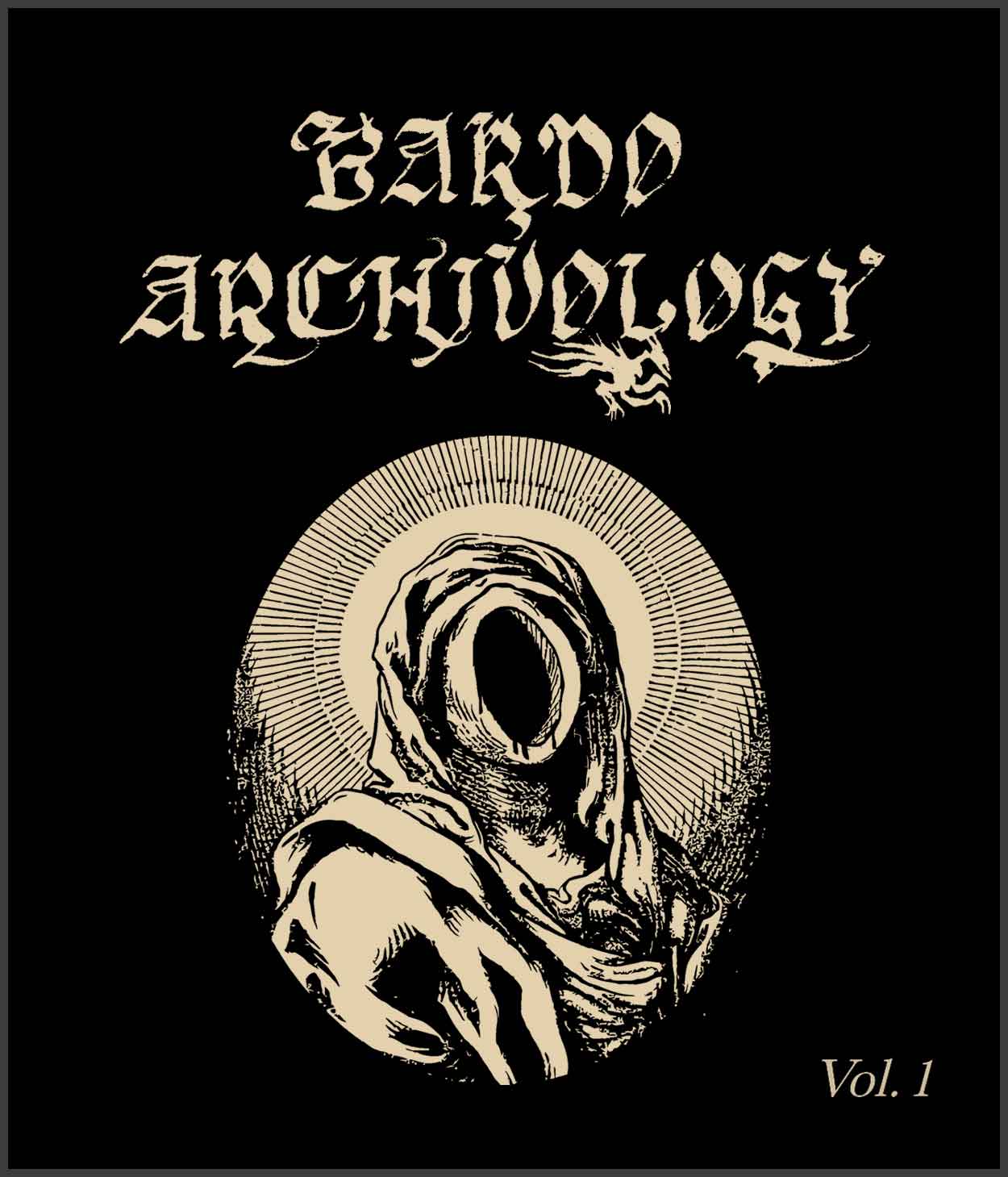Sunn O)))
2020-06-11
by Niklas Göransson
And the words rain down – a conversation about science, music, and mysticism with American guitarist Stephen O’Malley of experimental metal duo Sunn O))) as well as connoisseur label Ideologic Organ.
Here follows the first part of this conversation, whereas the second – which delves into Stephen‘s black metal-related work with Descent Magazine, Misanthropy Records, and The Ajna Offensive – is published in Bardo Methodology #6. The same issue also includes features with FUNERAL MIST, DEAD CAN DANCE, DEATHSPELL OMEGA, MYSTICUM, ADORIOR, Metalion, Dave Haley, OFDRYKKJA, Michael Denner, NECROS CHRISTOS, TEITANBLOOD, and Wim Hof.
– Leading up to the “Life Metal” project, Greg Anderson and I gathered as a duo for two writing sessions and composed root structures for several pieces of music – some arrangements for full compositions whereas others were individual sections, parts of suites, or even ideas we allowed to develop and grow during the studio session. We’d already made a pre-production demo elsewhere and were well-prepared with quite a lot of material to work on. Also, since we didn’t want to confine things, a number of arrangements and production elements were left to the recording process.
SUNN O)))’s two new albums – “Life Metal” and “Pyroclasts”, released by Southern Lord Records in April and October 2019, respectively – were recorded in Electrical Audio with legendary producer Steve Albini at the helm. Both received the AAA treatment, which means they were tracked, mixed, and mastered entirely on analogue tape.
– Both albums were recorded in the same session and have a very similar production, but the creative approach for “Pyroclasts” was a lot more open-ended. The “Life Metal” pieces were all composed and arranged whereas “Pyroclasts” was enacted on location in the studio, basically modal improvisations for a set duration. We performed a practice each day – both morning and evening, before and after the “Life Metal” sessions – meant to open and close the creative space. They had identical set-ups; we also mixed them at the same time. We were initially considering releasing everything altogether but decided that a triple album would just be too demanding.
The opening and only non-instrumental track on “Life Metal”, “Between Sleipnir’s Breaths”, uses as lyrics a remarkable pre-Aztec poem in which its author – a 15th century warrior, philosopher, and ruler known as Nezahualcoyotl, Hungry Coyote – most eloquently attempts to tackle the question of ‘Truly, do we live on Earth?’ The Norse-oriented title was initially confusing but makes more sense upon hearing the intro, which features sounds of horses borrowed from BATHORY’s “Oden’s Ride Over Nordland”. As the mythology goes, they were in turn sampled off the film Conan the Barbarian.
– The general idea was allowing for a possible instance of meditation, to evoke an imaginative visualisation. As for the poem itself, I was reading a lot about pre-Columbian history and the artistic and cultural side of that historical lineage. I discovered this set of poetry which had only recently been translated. There’s not much documentation remaining of the literature from these cultures, the Catholic Church essentially destroyed all of the codices written by their scholars. A few survived but it wasn’t until the 90s they could be properly deciphered.
Nezahualcoyotl and his later peers from the Aztec nobility collectively amassed the largest known body of poetry in all of Mesoamerica. These types of poems, collectively known as flower songs, often employ metaphors pertaining to plants and birdsong meant as reminders of how all life is as fleeting as it is precious. Aztec culture was by all accounts an inherently violent one, both in terms of politics and religion, which is why the pondersome melancholia characterising its poetic tradition stands in such stark contrast.
– I’d personally been exploring techniques from Tibetan Buddhism and found parallels in this poetry. Also, I’ve always been interested in Taoism and there are many angles as far as comparing philosophies in various cultures from different periods around the world. I’m not trained in anthropology or sociology enough to really comment on that, but I have found it fascinating. Besides, they’re simply beautiful; maybe it’s in the translation, but these poems have a highly visual sense of colour. They’re presented in a very invigorating visualisation which suited SUNN O)))‘s music. Or, rather, the poem didn’t suit the music but was appropriate to be presented alongside it. Furthermore, we have an Icelandic vocalist singing a pre-Colombian poem that’s been translated into English – really, in some ways, it’s a fully globalist concept.
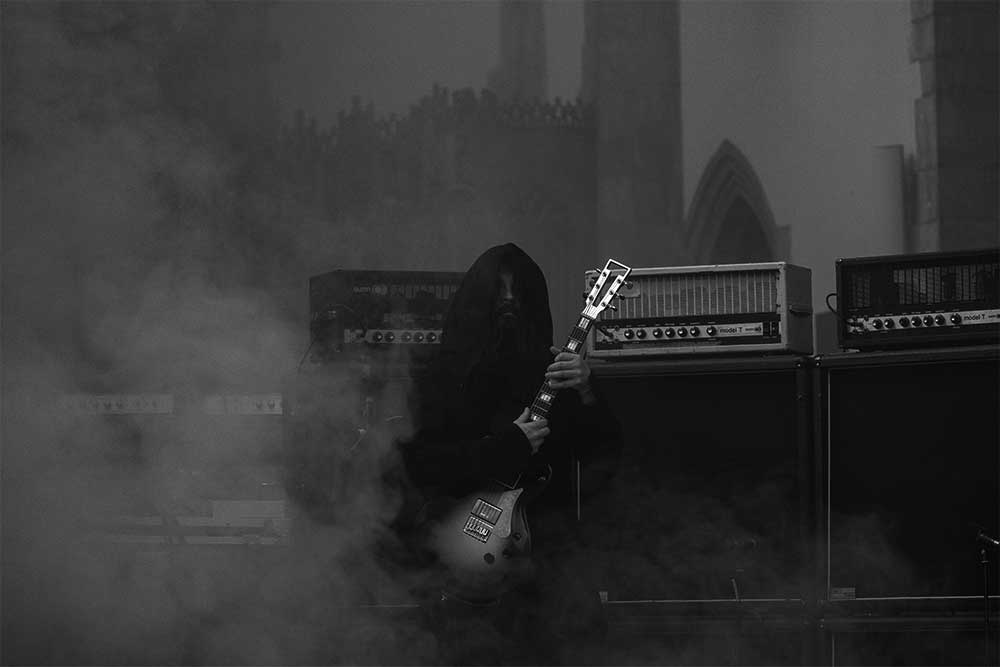
These existentially inquisitive verses are delivered by Icelandic composer and musician Hildur Guðnadóttir. A classically trained cellist and renowned solo musician, Guðnadóttir has also collaborated with various bands and artists – from THROBBING GRISTLE, MÚM, and PAN SONIC to Jóhann Jóhannsson – and composed the soundtrack for a number of motion pictures.
– She’s fantastic, isn’t she? Incredible musician, incredible artist, incredible person. We met at a festival in Italy some ten or twelve years ago. Sometimes it’s terrific to meet the person behind music you adore. Though not always, of course. Usually the opposite, right? But when you do connect with people, it’s wonderful and makes the appreciative depth for their work so much broader and it was like that with Hildur. We became close and when I was commissioned to make an ensemble piece for the Henie Onstad Kunstsenter series of music, I invited her along to participate as an ensemble player. She brought the haldorophone, an amazing discovery for me, this feedback-electric-cello type instrument. I was struck by her ability to remain openminded in her attempts to understand and cooperate with this instrument in producing music that’s really fascinating both within the context of compositional concepts and also her physical performance of the haldorophone, which is highly similar to how I experience playing guitar with SUNN O))).
After first sitting in with SUNN O))) on a festival they were both performing at, Guðnadóttir became an occasional guest to their live concerts. Over the last few years, she’s joined them for several significant shows such as their Convergence 2017 festival appearance at the Barbican in London.
–When Greg Anderson and I were planning what became “Life Metal”, we agreed on inviting Hildur to participate and she accepted, which is terrific. When she’s in the room, her very presence is just so effectivising. I’m sensitive to this quality and tend to be very moved by the charisma of the people involved. Her presence can be very discreet when necessary – like the section of “Novae” where she performs on the haldorophone in a concerto type of arrangement for several minutes. But, of course, when she’s stepping forward with her singing, it’s very obvious. We worked through the melodic vocal line in “Between Sleipnir’s Breaths” together, Hildur then used a medieval diaphonic singing technique she’d been exploring.

Another friend of Stephen’s who’s renowned for his exotic vocal technique is Alexey Tegin of Russian throat-chanting terrorists PHURPA – a ritual ensemble based on the musical traditions of Bön, the shamanistic spirituality of pre-Buddhist Tibet. Besides their otherworldly oration, PHURPA also incorporate several traditional Tibetan instruments crafted from both human and animal bones.
– Actually, Alexey performed here in Paris with his industrial project CORPS last night but, unfortunately, I wasn’t available to meet him. Just before you called, I was checking if he’s still in town as I’d hoped to see him today. I was introduced to PHURPA through some recordings given to me by my friend Randall Dunn when we were working together in his studio, probably around late 2009. I was into polyphonic singing and, of course, Tibetan music but didn’t really know about the Bön aspects of pre-Buddhist Tibetan history. And I certainly didn’t know about Alexey Tegin. At first it was simply about sonics and the mysticism surrounding it, which is a potent combination for my musical interests. As I looked into it a little deeper, I realised PHURPA had never released an LP. I wanted to start a new label and was given the opportunity to do so as a collaborative imprint under the Editions Mego umbrella. This was the seed that would grow into Ideologic Organ.
In 2011, Stephen founded Ideologic Organ – a record label with high-quality vinyl as primary focus. His very first release was PHURPA’s “Trowo Phurnag Ceremony” on double-LP.
– I thought it would be radical to launch the label by releasing a double-LP of longform throat-singing music. And since PHURPA had never done vinyl, the opportunity was multifold. Initially, I simply tried reaching them by email and eventually got in touch with Alexey’s wife, Svetlana. After releasing the album, I had a strange experience getting copies to them; I was asked to meet with a distributor in Paris, some Russian guy who’d go back and forth between Paris and Moscow carrying dance records to avoid import duty. I had to haul all these PHURPA double-LPs to this guy’s apartment in north Paris. Before meeting Alexey, but after I released the record, I discovered his background as a contemporary artist which blew me away – in particular his hyper-realism paintings and, also, some of the performance work he does with his wife. We met for the first time in 2015, when I invited PHURPA to perform as support for SUNN O))) on three UK dates.
Having had the privilege of interviewing him in person on three occasions – 2016, 2017, and 2018 – I must say that Alexey Tegin is truly one of the most intriguing characters I’ve ever come across. However, I can’t for the life of me imagine what cavorting about on a tour bus with PHURPA as travel companions would be like.
– We didn’t travel together, they were totally self-sufficient and would just show up at the venue; that was it. After arriving to the backstage, they started throat-chanting and doing headstands. The promoters seemed a bit afraid, or at least intimidated, by them – they look like a military group, they’re hard core. It was great. Alexey is a fascinating person, we’ve met several times since and even had the chance to collaborate and perform together at a very special event at the GES-2 in Moscow. I respect him greatly and enjoy our friendship, I feel that we’ve connected on a lot of levels. Alexey‘s backstory is very interesting; he’s an old-school industrial guy as well, his CORPS project is a remnant of that. And I find him to be very charming. I mean, definitely intense but he’s a true artist who’s forged a path that’s both radical and uncompromising but also very welcoming, because he’s constantly teaching this singing style to people who then become members of the ensemble for different periods of time. PHURPA’s concept lives in multiple universes. He’s also profoundly driven and interested in the experience of the present situation, living in this altered space of creation. I appreciate that as I can relate to this in some ways with my own musical work. Alexey is also devoted to the powers of sound. Not only with his voice as medium, not just the mysticism side, but through sheer sonic force.
Alexey makes frequent references to ‘power’ as both the source and purpose of his music. Stephen often speaks in similar terms about what he calls ‘sound energy’. With energy mentioned in this context, I’d like to know if it’s used in a mystical sense or something more akin to quantum physics.
– Well, both really, it depends where I’m at in the present. Currently, I’d say it would be in terms of quantum physics, but making it ethereal is very easy; I suppose it depends on your approach to the relation of science, philosophy, and magic. Oftentimes, these are different vocabularies but with the same underlying terminology. When it comes to power, it is literally electrical power transforming through a circuit into the feedback of acoustic resonation energy. But I totally connect with Alexey on that level, it’s incredible what the human diaphragm can do in terms of projecting acoustics which affect the surrounding molecular field – only by re-circulating feedback of gas, that’s incredible. He’s also highly focused on the correct type of voice amplification and that’s the root of the sonic power of their music in performance.
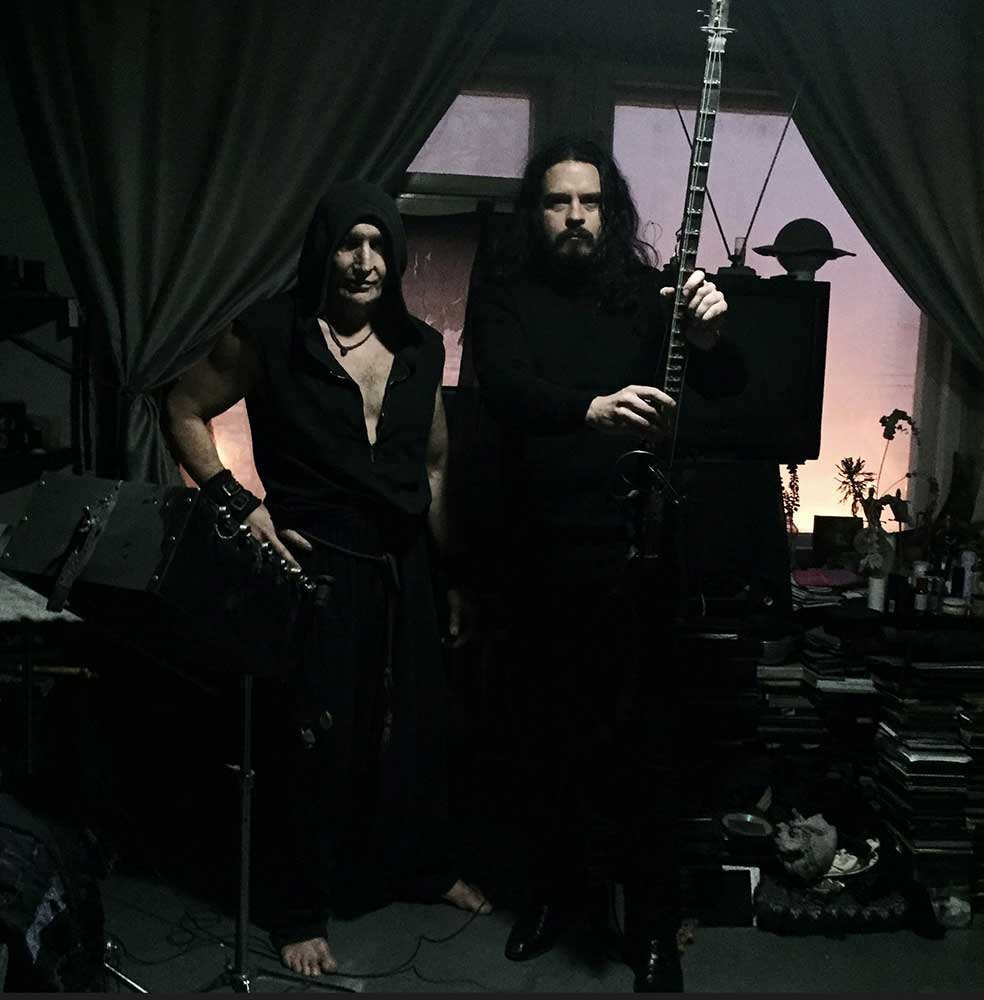
Psychoacoustics, the discipline of using sound as stimuli to the human physiology and psychology – is this something you’ve dabbled with?
– Absolutely, and not only ‘dabbled’… for me, most of my music actually focuses on psychoacoustics as a fundamental quality of the sound experience. It’s very easy to connect these psychoacoustic ideas to the scientific side of quantum theory and through contemporary physics such as string theory; it then becomes a philosophical question about the very nature of sound and music. Essentially, disrupting or modifying the state of matter through vibrations. Reminding the mind of the possibilities of this fundamental aspect that is vibrations, of which all matter is composed. The psychoacoustic aspect of the composition process is pretty interesting. For example, there are a few moments on the “Monoliths & Dimensions” album (2009) with very low concert bass drums. They’re inaudible on a lot of sound systems but on certain setups there’s a very tangible physical energy surging through the room when those bass drums are struck. It doesn’t sound like a bass drum, it’s a deep vibration wave of low pitch moving across the room. We’ve used synthesis and low frequencies when working with composition but there’s more to it than that, of course. There are some higher-frequency feedback harmonies and such which serve a similar purpose. Psychoacoustics involve all filters of the mind, it’s not simply a physical phenomenon – the attention to the wave and vibration of nature through the sound experience.
Stephen has worked extensively with several masters of this field, such as American composer and Professor of Music Alvin Lucier. A former member of the Sonic Arts Union collective, Lucier works primarily with experimental sound installations geared towards the finer details of auditory perception, resonance, and acoustics.
– He’s an expert on intonation, an expert on harmony, mathematics… somehow, his work is the most poetic music I’ve ever heard. We worked together in an ensemble and he’s written music for me to perform. The man is fascinating, he’s in his late eighties now but spent his life studying and teaching these topics. He’s very articulate, you should really check out his written work. Just a word of warning though, he considers his recordings to be mere documentations incapable of accurately reflecting the full scope of the live experience. When his music is performed, the entire concert space is activated; the compositions are designed to promote phenomena of standing waves sweeping, moving, and transforming throughout the hall. Very poetic, very beautiful.
Stephen adds that he’s also had the honour of working with other composers, such as Romanian spectralist Iancu Dumitrescu.
– Dumitrescu is deeply driven and informed by his own impression of the concepts of phenomenology. I believe Alexey Tegin moves a bit in this area too, although he’s essentially working with a kind of ‘ethnic music’, right? His music has a lot of overtones of ritual and ceremony. In fact, they are religious chants and prayers. I haven’t gone into it with him as far as the theological aspect goes, but I’m aware that, like many of the Himalayan philosophical stories, Bön deals with a kind of disintegration of the perceived. But if you look at just the physical aspect of what they’re doing, it’s psychoacoustic as well. With the voice as source, mind you, which is incredible. To paraphrase Joan Labarbara, ‘voice is the original instrument’.
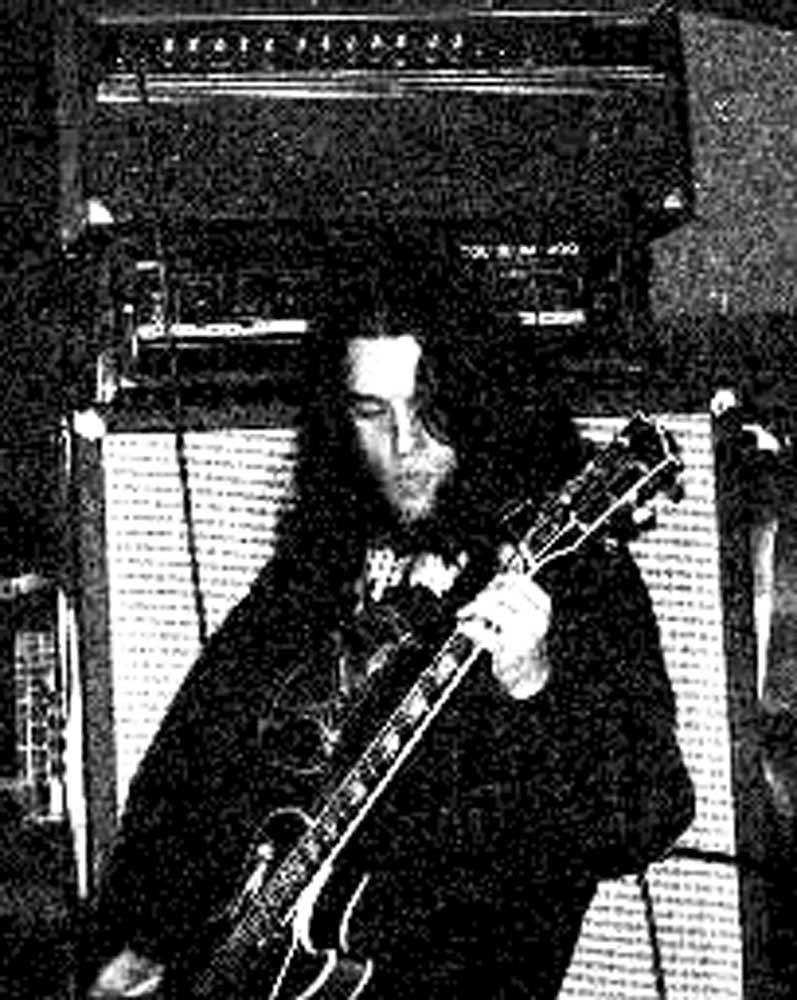
One recurring topic in these conversations is Pythagorean tuning, as discussed at some length with the aforementioned Alexey Tegin in Bardo Methodology #5. What lies at the very heart of the matter is the actual number 432, a numerical order with an impressive prevalence throughout science, nature, and spiritual traditions from all corners of the earth. The sonic side of this conundrum leads to a long-standing debate within the music community, whether tuning an instrument to 432 Hz leaves it attuned to the ‘frequency of the universe’ – resounding in sonic harmony with that of the natural world, and so forth. I’m wondering if Stephen is familiar with the theory.
– Yes. We’ve performed some of Alvin Lucier‘s pieces with The Ever Present Orchestra using an ensemble setting featuring not only four electric guitars but also other instrumentation like violin and saxophone. Mr Lucier‘s expertise on intonation is so precise that we had to play the pieces in 432 Hz instead of 440. However, I believe this is a compositional intonation choice in relation to that particular music piece – not ‘Harmony of the Spheres’, which is a topic often misconstrued for low-level mystical infusion of musical practice.
Musica universalis, or Harmony of the Spheres, is a school of musical thought established by 6th century BC Hellenic academic Pythagoras of Samos, the architect behind the diatonic scale – a ruleset for musical notes upon which basically all Western composition from medieval times until the 20th century was based. The multidisciplinary scholar believed music to be entwined with both mathematics and astronomy, and argued that the numerical logic behind musical intervals mirrors the distances, sizes, and orbits of the planets in our solar system.
– Aside from Pythagorean developments of mathematics and, essentially, trigonometry and geometry – which, at the time, were inseparable from ideas of harmony and ratio – these 432 and 440 Hz frequencies historically arose to regulate how a score of classical music sounded in different cultures around Europe. For example, the Vienna orchestra would tune higher at 460 and the orchestra in Wroclaw to 400 and, at some point, it became a kind of regulation standard to keep orchestras throughout Europe in sync. Sort of like the atomic clock, but for musical pitch.
As Stephen points out, the concert pitch is the target frequency every member of an ensemble tunes their instruments to. A432 – meaning, note A above middle C tuned to 432 Hz – is believed to have been the pitch of choice for Western musicians until the early 16th century. There are many claims of excavated Ancient Greek and Egyptian instruments having been constructed for 432 Hz, but this appears impossible to verify one way or the other from internet research alone. Nevertheless, this is known for a fact to have been the case with the original 17th century Stradivarius violins. For the past hundred years or so, 440 Hz has been the unofficial international standard tuning pitch, although no one seems to be quite certain as to how this happened.
– The 19th century saw a strange kind of arms race in different regions of Europe, with the concert pitch creeping higher and higher. Stravinsky suffered the end of this. Much has been written on the music of the greatest composers, Bach and Beethoven, how the music they composed probably had more fluidity, improvisation, and space to perceive the harmonic structure between notes than it currently has. Since classical music is so impressive on a virtuosic level, the increase of tempo showcased that potential for power in ways which were possibly not intended by its composers.
The reason why A432 has Pythagorean connotations is because when tuning an instrument in accordance to Harmony of the Spheres, note A above middle C produces the illustrious audio frequency. However, this is unlikely to have been of Pythagoras’ own conscious design, seeing as how Hertz – the measurement unit for wave frequencies of sound, radio, and light, which calculates the number of times per second the full cycle of a vibration occurs – has only been in use since 1933.
– The tuning of most instruments in the West is, of course, based on equal tempered intonation; meaning, chromatic dividing the octave into twelve even intervals of which the diatonic is part, though that’s not always truly the case. These intervals are not mathematically correct as far as harmony is concerned, which has led to many psychoacoustic sound colours in Western musical history which are, in fact, based on disharmony. I appreciate topics such as Harmony of the Spheres and ideas like ‘the frequency of the universe’, but let’s keep things in reality here when talking about music and mathematics. This is a deep topic which has been thoroughly explored by very interesting artists like Tony Conrad – “Slapping Pythagoras”, how punk is that title? – Lucier, as well as American folk artists like Fahey and Basho. And, of course, Alexey’s practices, as the voice truly isn’t tempered to any interval except what the mind perceives as correct. In fact, the idea of harmony in music is more as importantly set by cultural codes and conditioning than it is mathematical beauty. Hence gagaku, ragtime, dhrupad and Hindustani music, etcetera.
Besides resting on fundamentally different tonal structures, the main contrasting features of traditional Indian music as compared to Western is that it’s based on melody, sequences of single notes played in a given order, whereas the latter relies on harmony – a group of notes, or chords, played in unison – along with counterpoints and texture.
– I’m obviously far from an expert but rather an eager, if ignorant, enthusiastic, and curious amateur… but these are important intellectual topics which also cross over into the deep experiential core of my work and passion for music. Thus philosophical. It’s easy for people to use these borderline esoteric ideas to move into loose pseudo-theoretical New Age bullshit, making it all very cloudy and, may I add, romantic and subjective. Which distorts Harmony of the Spheres, ‘The fifth hammer’, and similar concepts. In fact, to do this dilutes the beauty of the topic and the reality of sound and mathematics. People want to believe in something that will heal them in a fundamental way and bring them closer to ‘truth’. But talking about frequencies on human-based measurements of our perception of space and using arbitrary units of time… no.
I should point out that I’m personally not arguing for anything besides the absurdity of all these alleged coincidences. My interest in this topic is not to promote any theories pertaining to ‘sacred tuning’ or ‘healing frequencies’, much of it sounds like absolute twaddle and appears to be primarily peddled by people who are mentally unwell. Still, it’s hard to write off these recurring numerical phenomena as random happenstance. Really, isn’t it mildly curious that when tuning an instrument in accordance to a 2,500-year-old Hellenic procedure – one its engineer claims mirrors astral bodies and planetary cycles – it generates an audio frequency vibrating 432 times per second? As for arbitrary units, the sexagesimal method of measuring geographic coordinates, angles, and time we use today is based on the Babylonian system for astronomy and mathematics, which they inherited from the Sumerians. This is why our hours are divided into sixty minutes consisting of sixty seconds, and also why we have 360 degrees (6×60) in a full circle. As it happens, 432,000 was the ‘number of the aeon’, concluding one age and commencing another, in both ancient Sumer and Babylon. Multiply 432 with sixty and you get 25,920, which is the exact amount of years it takes for the Earth to rotate on its axis and complete a cycle of the precession of the equinoxes. Every March and September, on equinox days, the sun is directly above the Equator and makes day and night of identical length, each consisting of 43,200 seconds. After reading the PHURPA feature in Bardo Methodology #5, Ignis Fatuus, the drummer of PORTAL, shared an observation:
I noticed something interesting about the numbers in the Bön religion. If A4 (above middle C) = 432 Hz
A0 = 27 Hz (3x3x3)
A2 = 108 Hz (Bön)
A4 = 432 Hz
These are all two octaves apart and line up with both equal temperament and just systems. It’s quite interesting how it all conveniently lines up but also interesting that the notable numbers skip an octave too (even though 218 is also A3).
In the conversation with Alexey, we learned that 108 is the ‘secret number’ in the Bön religion. Just like 432, 108 is embedded in many different spiritual traditions. For example, the world’s oldest written work, the Hindu scriptures known as Rg Veda, contains precisely 432,000 syllables over 108 stanzas. 432,000 is the amount of years in Kali Yuga, final stage of the Hindu great cycle of ages; concluding one epoch and commencing another. As for twenty-seven, A0, Alexey explained that – following esoteric Bön logic too complex to delve into here – this number is the fundamental building block of 108. Twenty-seven, in turn, is derived from thrice multiplying the sacred number three with itself, a so-called math cube. Meaning, three times three times three, landing us at twenty-seven. Twenty-seven times four is 108, which times four is 432. By the way, 3+3+3 – 2+7 – 1+0+8 – 4+3+2, all these numerical series grouped together equal nine, another significant number within religiosity worldwide. Nine is especially prevalent in the Norse mythos, which is why it bears mentioning that, according to the Poetic Edda, 432,000 chosen warriors will emerge from Valhalla to fight at Ragnarök. And it’s not just spirituality, far from it: in 1983, computerised tests carried out by US golfing brand Wilson determined that a golf ball with 432 dimples flew farther than any other. This is but a smidgeon of all the peculiar connections, but it really does one’s head in trying to make sense of it all.
– One must be very careful to recall that, in the time of Pythagoras, music had a very different purpose and the harmony he was writing about – or, actually, more accurately, what others wrote he taught – was unravelling ratio and geometric mathematics. Systems to provide a sense of logic and reason. These were not fully explained rules on a cosmological level. Even with diatonic music in Western composition, you’re still dealing with twelve tone octaves which are not only approximations of pure harmony, which then become culturally conditioned, but they are extremely limited and specific compared to how other cultures split up octaves. But it’s interesting, with Lucier‘s music some of the players asked, ‘We really have to change shit eight Hz, who cares?’ Well, actually, also in the ensemble is a glockenspiel player named Trevor Saint; he’s very close to Mr Lucier, kind of his assistant.
The glockenspiel is a percussion instrument designed to ‘lift’ the feeling of tone of the other instruments in an orchestra.
– Because the glockenspiel was tuned at a slightly higher pitch, with those eight Hz there the harmony ended up quite different – especially with six instruments involved. When that eight-Hz shift happened in the other five players, the harmony locked and it both sounded and felt really different. Since Lucier works using harmony to create standing waves, that wave will move. Those kinds of details are part of it, exacting articulation, and it’s pretty interesting. But not only is he an artist in a sculptural and poetic sense, he’s evidently also a genius. I’m saying all of this as an electric guitarist with my usual equal tempered fretboard attached to a slab. A truly primitive situation when exploring such a broad topic as harmonics, indeed! I’m trying to work this out and my place within these ideas, which is perhaps my music in a nutshell.
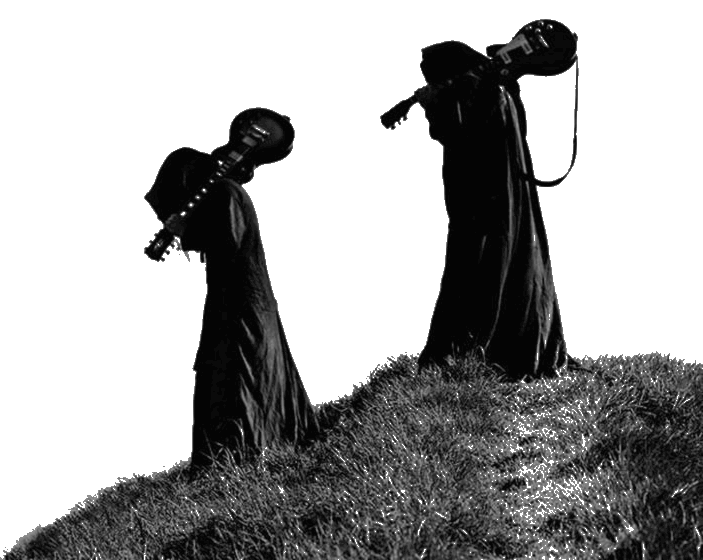
You’ve reached the end of the first part of this conversation, the second – which delves into Stephen‘s black metal-related work with Descent Magazine, Misanthropy Records, and The Ajna Offensive – is published in Bardo Methodology #6. The same issue also includes features with FUNERAL MIST, DEAD CAN DANCE, DEATHSPELL OMEGA, MYSTICUM, ADORIOR, Metalion, Dave Haley, OFDRYKKJA, Michael Denner, NECROS CHRISTOS, TEITANBLOOD, and Wim Hof.
